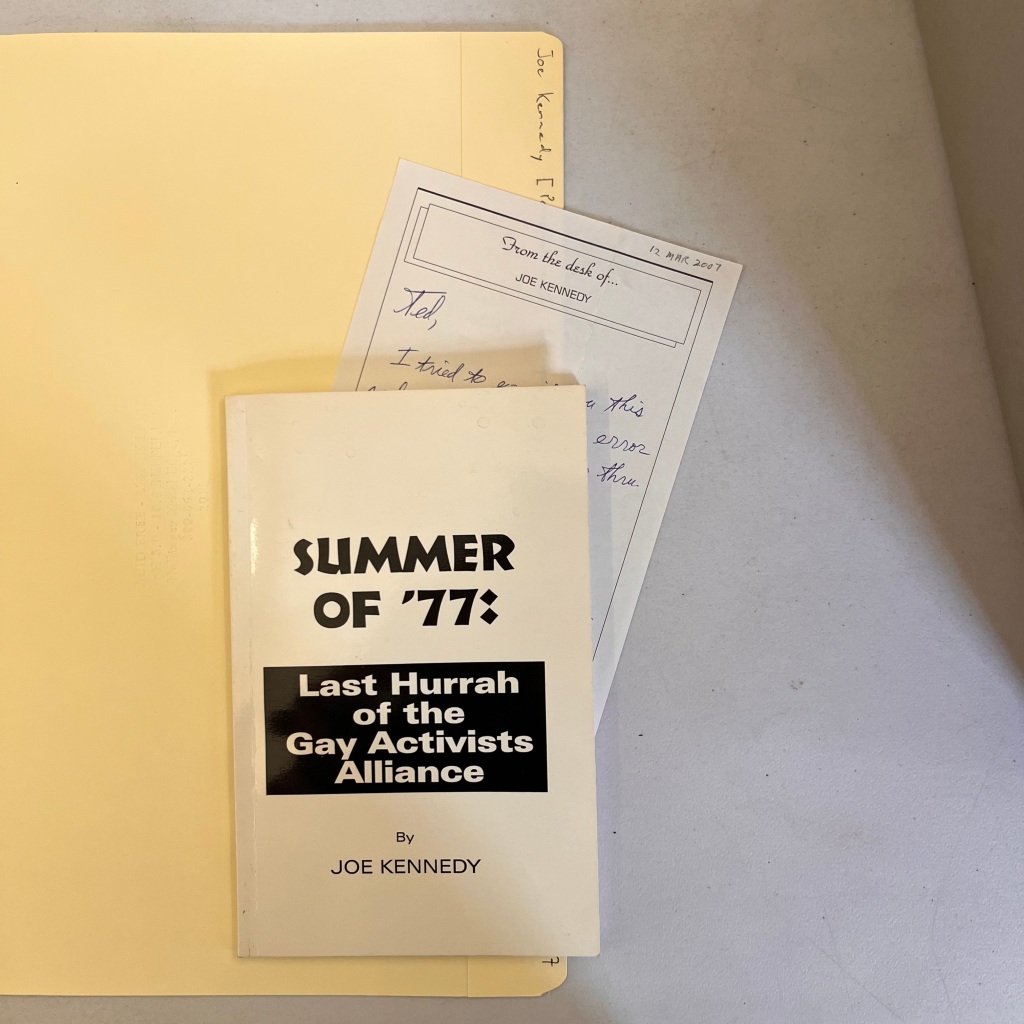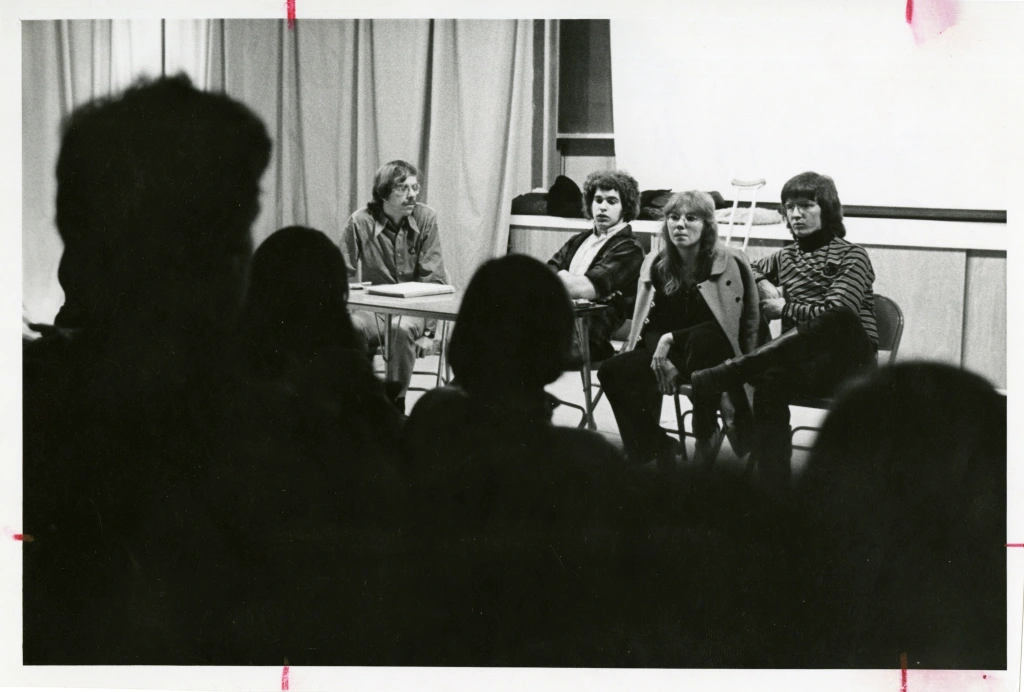The Gay Activists Alliance was a post-Stonewall LGBTQ+ rights group. The radical activist group was focused on gay liberation (and nothing less) and used a wide variety of in-your-face, news-grabbing tactics in their efforts to achieve this.
The GAA’s activism put them on the FBI’s radar, and their approach became highly influential in shaping LGBTQ+ action and organizing for decades to come. Because of their geographic proximity and personal connections to Westchester County, the GAA became involved in Westchester LGBTQ+ affairs several times in the 1970s and after.
The GAA became well known for its “zaps,” a method of protest described by the NYC LGBT Historic Sites Project as “a direct, surprise public confrontation with political figures and corporate and governmental entities regarding gay rights and discrimination, designed to gain gay and straight media attention.”
In addition to a number of zaps in New York City, the GAA also held a zap in Scarsdale, N.Y., on August 4, 1977. It took place at the residence of Democratic Party politician Adam Walinsky, who had recently published an op-ed voicing his disapproval of a proposed gay rights bill for New York City.
The most thorough account of this zap that the Westchester LGBTQ+ History Project has been able to identify comes from the book Summer of ’77: Last Hurrah of the Gay Activists Alliance by GAA member Joe Kennedy. Kennedy, who chose to leave the public sphere as an activist in the 1980s, was originally from Westchester and even ran for Eastchester Town Supervisor in the early 1970s.

According to Kennedy’s account, a 50-person convoy, accompanied by two unnamed civil liberties lawyers and a handful of gay media reporters, arrived at the Walinsky residence at approximately 11:30pm. This convoy arrived moments after “persons unknown” (unclaimed by the GAA and described as such in police reports) had been on the scene, spray-painting the Walinsky driveway, cutting phone lines, and bombarding the home with eggs.
Kennedy’s description of the events that followed after the GAA arrived is excerpted here:
Only after the GAA protesters set up a picket line on the street (there was no sidewalk) in front of Walinsky’s did they suddenly and dramatically unleash their deafening cacophony: noisemakers galore – bells, whistles, drums, horns, tambourines – and a non-stop repertoire of bullhorn-led chanting.
They shouted: “BIGOT WALINSKY, you better start shakin’, today’s pig is tomorrow’s bacon!” They yelled: “2, 4, 6, 8, Gay is good, gay is great! Gay power now!” They howled: “Walinsky, you liar, we’ll set your ass on fire! Gay rights now!”
In spite of Walinsky’s heated – hysterical might be a better word – demands, the Scarsdale Police who finally showed up at the scene declined to arrest any of the GAA pickets. After conferring with GAA’s spokesperson and the two legal observers, the Scarsdale Police official in charge explained to Walinsky that the only thing police could see was a more-or-less legal, albeit very noisy, picket line of baseball-bat-wielding protesters in progress on a public street – and, purely coincidentally, evidence that telephone wire-cutting and numerous other felonies had recently occurred nearby on Walinsky’s property.
Summer of ’77: Last Hurrah of the Gay Activists Alliance by Joe Kennedy
The GAA protestors left the scene after an hour of protests. No arrests were made.
Editor’s note: The Westchester LGBTQ+ History project is in the process of attempting to identify photographs of this event, in addition to images of flyers allegedly left behind at the Walinsky residence, on-scene media coverage of the event, and police reports. This page will be updated with this documentation if it is discovered and approved for publication here.
Following the protests, Walinsky filed a massive lawsuit against the GAA, which dragged on for two years and ended with an out-of-court settlement. Correspondence from Joe Kennedy shows that Harris L. Kimball, an openly gay lawyer who worked in Westchester for many years, assisted the GAA during the earliest months of the lawsuit.

Years prior to this event, the GAA came to Westchester on a less showy but equally important mission. In March 1971, invited speakers from the GAA held a small panel for an audience of 200 students and adults at at Horace Greeley High School.
“We’re not fighting for acceptance, just an end to legal and public discrimination,” said then-president of the GAA Jim Allison, according to a newspaper article published in the Mount Kisco Paper The Patent Trader.

Two years later, the GAA spoke at a similar program for high school students in Scarsdale.
The GAA again became involved in Westchester events in 1980, when police officers for towns and cities within the county became involved in coordinated efforts to arrest men presumed to be gay at train station restrooms. In response to this spate of arrests, which the GAA described in one letter to public officials as “vicious harassment of homosexuals,” the group threatened mass protests.
Sources
“Gay Activist Alliance.” FBI Records: The Vault. October 19, 2023. https://vault.fbi.gov/gay-activist-alliance-part-01-of-02
“Gay Activists Alliance.” NYC LGBT Historic Sites Project. August 29, 2023. https://www.nyclgbtsites.org/theme/gay-activists-alliance-actions/
Kennedy, Joe. Summer of ‘77: Last Hurrah of the Gay Activists Alliance. Westport, CT: PPC Books, 1994. https://web.archive.org/web/20230410075128/http://www.gaynewsandviews.com/summerof77.htm
Kennedy, Joe. “Joe Kennedy Looks Back: An Aging LGBT Activist’s Personal Memoir in Words & Pictures.” Gay News and Views. October 4, 2023. https://web.archive.org/web/20230409111938/http://www.gaynewsandviews.com/memoir.html
Kennedy, Joe. “Letter to Harris Kimball from The Gay Activist’s Alliance.” Correspondence. December 10, 1977. Harris L. Kimball papers, #7823. Division of Rare and Manuscript Collections, Cornell University Library.
Forsyth, Mimi. “Gay Activists Alliance member Barbara Glover answers a student question at Horace Greeley High School. To her left is Alliance president Jim Allison and to her right Greeley student Fred Sanders and another Alliance member David Doyle.” 1971. Photograph. The Patent Trader, 13, March 20, 1971. https://nyshistoricnewspapers.org/?a=d&d=pt19710320-01.1.13&e=——-en-20–1–txt-txIN———-
Coats, Barbara. “‘End discrimination’ homosexuals ask.” The Patent Trader (Mount Kisco, NY), March 20, 1971, 13. https://nyshistoricnewspapers.org/?a=d&d=pt19710320-01.1.13&e=——-en-20–1–txt-txIN———-
Johnson, Peter. “White Plains locks depot men’s room.” The Standard Star (New Rochelle, NY), July 31, 1980, 4.
Leave a comment